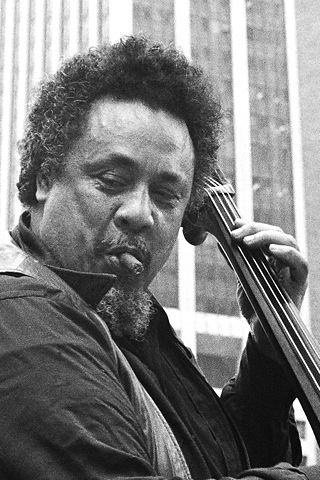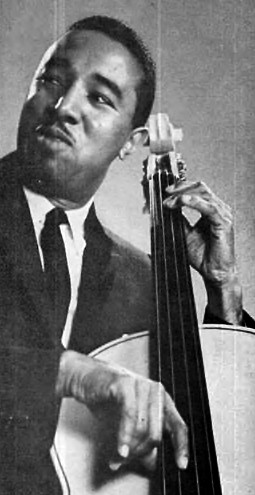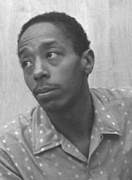
Charles Mingus Jr. was an American jazz upright bassist, composer, bandleader, pianist, and author. A major proponent of collective improvisation, he is considered one of the greatest jazz musicians and composers in history, with a career spanning three decades and collaborations with other jazz greats such as Duke Ellington, Charlie Parker, Max Roach, and Eric Dolphy. Mingus's work ranged from advanced bebop and avant-garde jazz with small and midsize ensembles to pioneering the post-bop style on seminal recordings like Pithecanthropus Erectus (1956) and Mingus Ah Um (1959) and progressive big band experiments such as The Black Saint and the Sinner Lady (1963).

Joe Pass was an American jazz guitarist. Although Pass collaborated with pianist Oscar Peterson and vocalist Ella Fitzgerald, his status as one of the most notable jazz guitarists of the 20th century is generally attributed to his work on his solo albums, such as Virtuoso.

Charles Parker Jr., nicknamed "Bird" or "Yardbird", was an American jazz saxophonist, bandleader, and composer. Parker was a highly influential soloist and leading figure in the development of bebop, a form of jazz characterized by fast tempos, virtuosic technique, and advanced harmonies. He was a virtuoso and introduced revolutionary rhythmic and harmonic ideas into jazz, including rapid passing chords, new variants of altered chords, and chord substitutions. Parker was primarily a player of the alto saxophone.

Maxwell Lemuel Roach was an American jazz drummer and composer. A pioneer of bebop, he worked in many other styles of music, and is generally considered one of the most important drummers in history. He worked with many famous jazz musicians, including Clifford Brown, Coleman Hawkins, Dizzy Gillespie, Charlie Parker, Miles Davis, Duke Ellington, Thelonious Monk, Abbey Lincoln, Dinah Washington, Charles Mingus, Billy Eckstine, Stan Getz, Sonny Rollins, Eric Dolphy, and Booker Little. He also played with his daughter Maxine Roach, a Grammy nominated violist. He was inducted into the DownBeat Hall of Fame in 1980 and the Modern Drummer Hall of Fame in 1992.

Clifford Benjamin Brown was an American jazz trumpeter, pianist and composer. He died at the age of 25 in a car crash, leaving behind four years' worth of recordings. His compositions "Sandu", "Joy Spring", and "Daahoud" have become jazz standards. Brown won the DownBeat magazine Critics' Poll for New Star of the Year in 1954; he was inducted into the DownBeat Hall of Fame in 1972.

Oscar Pettiford was an American jazz double bassist and composer. He was one of the earliest musicians to work in the bebop idiom.

Arthur Stewart Farmer was an American jazz trumpeter and flugelhorn player. He also played flumpet, a trumpet–flugelhorn combination especially designed for him. He and his identical twin brother, double bassist Addison Farmer, started playing professionally while at high school in Los Angeles. Art gained greater attention after the release of a recording of his composition "Farmer's Market" in 1952. He subsequently moved from Los Angeles to New York, where he performed and recorded with musicians such as Horace Silver, Sonny Rollins, and Gigi Gryce and became known principally as a bebop player.

The Modern Jazz Quartet (MJQ) was a jazz combo established in 1952 that played music influenced by classical, cool jazz, blues and bebop. The Quartet consisted of John Lewis (piano), Milt Jackson (vibraphone), Percy Heath, and various drummers, most notably Kenny Clarke and Connie Kay. The group grew out of the rhythm section of Dizzy Gillespie's big band from 1946 to 1948, which consisted of Lewis, Jackson, and Clarke along with bassist Ray Brown. They recorded as the Milt Jackson Quartet in 1951 and Brown left the group, being replaced on bass by Heath. During the early-to-mid-1950s they became the Modern Jazz Quartet, Lewis became the group's musical director, and they made several recordings with Prestige Records, including the original versions of their two best-known compositions, Lewis's "Django" and Jackson's "Bags' Groove". Clarke left the group in 1955 and was replaced as drummer by Kay, and in 1956 they moved to Atlantic Records and made their first tour to Europe.

Raymond Matthews Brown was an American jazz double bassist, known for his extensive work with Oscar Peterson and Ella Fitzgerald. He was also a founding member of the group that would later develop into the Modern Jazz Quartet.
A quintet is a group containing five members. It is commonly associated with musical groups, such as a string quintet, or a group of five singers, but can be applied to any situation where five similar or related objects are considered a single unit.

St. Elmo Sylvester Hope was an American jazz pianist, composer, and arranger, chiefly in the bebop and hard bop genres. He grew up playing and listening to jazz and classical music with Bud Powell, and both were close friends of another influential pianist, Thelonious Monk.

Nathaniel Carlyle Adderley was an American jazz trumpeter. He was the younger brother of saxophonist Julian "Cannonball" Adderley, whom he supported and played with for many years.

Paul Bley, CM was a Canadian jazz pianist known for his contributions to the free jazz movement of the 1960s as well as his innovations and influence on trio playing and his early live performance on the Moog and ARP synthesizers. His music has been described by Ben Ratliff of the New York Times as "deeply original and aesthetically aggressive". Bley's prolific output includes influential recordings from the 1950s through to his solo piano recordings of the 2000s.

Roy Anthony Hargrove was an American jazz musician and composer whose principal instruments were the trumpet and flugelhorn. He achieved worldwide acclaim after winning two Grammy Awards for differing styles of jazz in 1998 and 2002. Hargrove primarily played in the hard bop style for the majority of his albums, but also had a penchant for genre-crossing exploration and collaboration with a variety of hip hop, neo soul, R&B and alternative rock artists. As Hargrove told one reporter, "I've been around all kinds of musicians, and if a cat can play, a cat can play. If it's gospel, funk, R&B, jazz or hip-hop, if it's something that gets in your ear and it's good, that's what matters."

'Round About Midnight is a studio album by the jazz trumpeter and composer Miles Davis with his quintet. It was released through Columbia Records in March 1957, and is Davis's first record on the label. The recording took place at Columbia's New York studio in three sessions between October 1955 and September 1956.

Filles de Kilimanjaro is a studio album by the American jazz trumpeter Miles Davis. It was recorded in June and September 1968 at Columbia 30th Street Studio in Manhattan, New York City, and released on Columbia Records in December of that year in the United Kingdom and in the United States the following February. The album is a transitional work for Davis, who was shifting stylistically from acoustic post-bop recordings with his Second Great Quintet to the jazz fusion of his subsequent "electric period". Filles de Kilimanjaro was well received by contemporary music critics, who viewed it as a significant release in modern jazz. Pianist Chick Corea and bassist Dave Holland appear on two tracks, marking their first participation on a Davis album.

Nefertiti is a studio album by the jazz trumpeter and composer Miles Davis. It was released in March 1968 through Columbia Records. The recording was made at Columbia's 30th Street Studio over four dates between June 7 and July 19, 1967, the album was Davis' last fully acoustic album. Davis himself did not contribute any compositions – three were written by tenor saxophonist Wayne Shorter, two by pianist Herbie Hancock, and one by drummer Tony Williams.

Tom Harrell is an American jazz trumpeter, flugelhornist, composer, and arranger. Voted Trumpeter of the Year of 2018 by Jazz Journalists Association, Harrell has won awards and grants throughout his career, including multiple Trumpeter of the Year awards from DownBeat magazine, SESAC Jazz Award, BMI Composers Award, and Prix Oscar du Jazz. He received a Grammy Award nomination for his big band album, Time's Mirror.
Hal McKusick was an American jazz alto saxophonist, clarinetist, and flutist who worked with Boyd Raeburn from 1944 to 1945 and Claude Thornhill from 1948 to 1949.
Inner City Records was a jazz record company and label founded by Irv Kratka in 1976 in New York City.
















